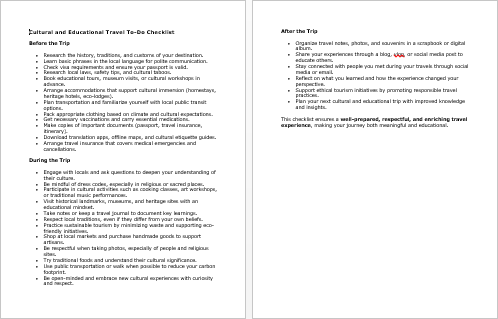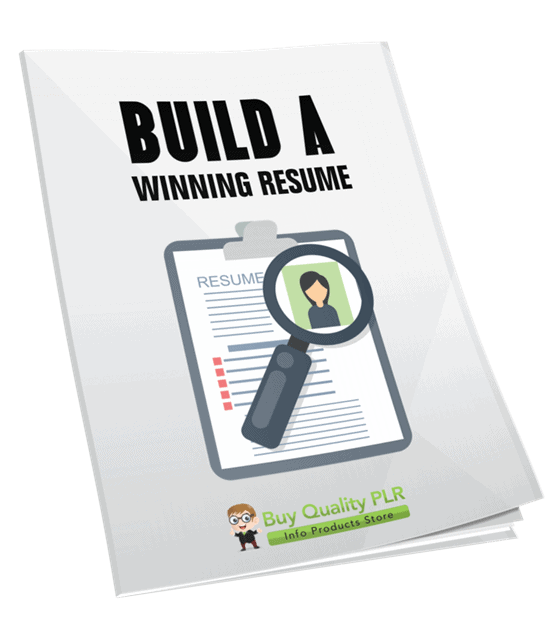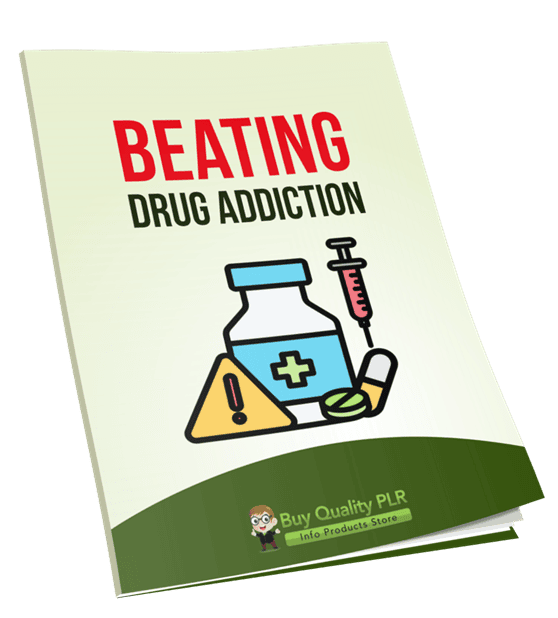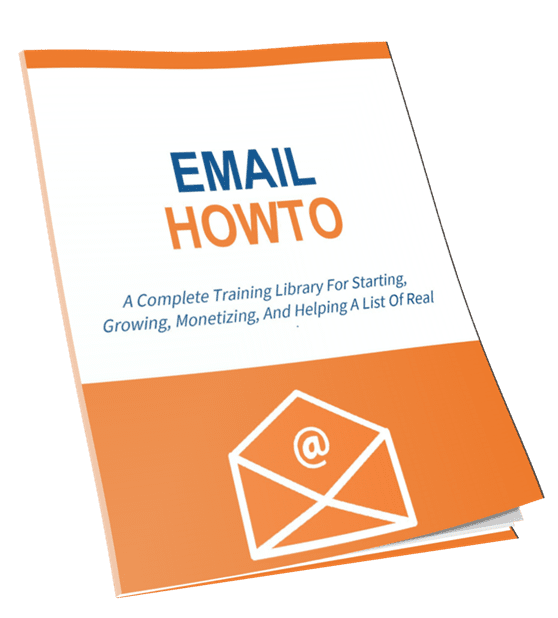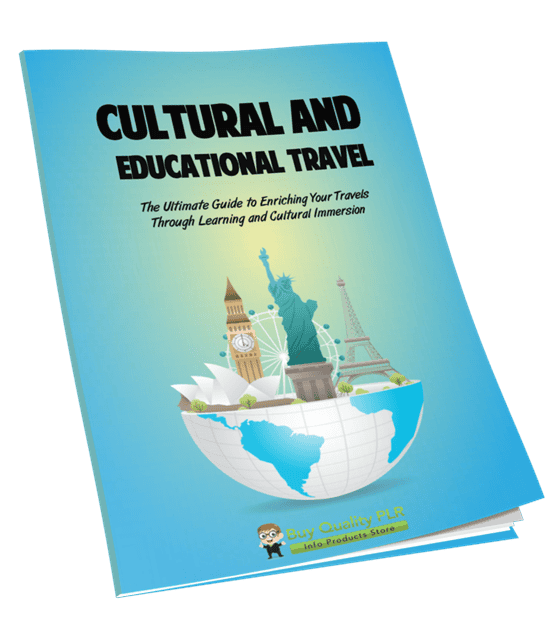
Cultural and Educational Travel PLR Course 22k Words
in PLR Checklists , PLR eBooks , PLR eCourses , PLR List Building Reports , Premium PLR , Premium PLR eBooks , Premium PLR Reports , Premium White Label Brandable PLR Coaching Courses , Private Label Rights Products , Travel PLR , Travel PLR eBooksChoose Your Desired Option(s)
has been added to your cart!
have been added to your cart!
#culturaltravel #educationaltravel #travelplrcourse #plrcontent #plrtravel #traveleducation #onlinecoursecontent #privatelabelrights
Cultural and Educational Travel PLR Course: The Ultimate Guide to Enriching Your Travels Through Learning and Cultural Immersion
Are you ready to help others make their travels more meaningful and impactful? With the Cultural and Educational Travel PLR Course, you can guide your audience through the rewarding process of exploring new cultures, learning, and deepening their travel experiences. Whether your customers are solo travelers, families, or student groups, this comprehensive course is the perfect resource for those looking to create unforgettable journeys full of cultural and educational enrichment.
This 20,017-word PLR course is designed to be easy to follow, practical, and packed with actionable tips. From preparing for a cultural trip to reflecting on experiences after returning, the course covers everything needed to transform an ordinary trip into a life-changing adventure.
Presenting…
Cultural and Educational Travel PLR Course 22k Words
Course Overview: Your Step-by-Step Guide to Cultural and Educational Travel
The Cultural and Educational Travel PLR Course is divided into five well-structured modules that will teach your audience how to plan, engage, and reflect on their travels, focusing on cultural immersion and educational experiences.
Module 1: Preparing for a Cultural & Educational Trip
Successful cultural and educational travel starts long before you arrive at your destination. This module helps your audience prepare by defining their travel goals and researching destinations.
- Step 1: Define Your Purpose and Goals – Identify the key learning outcomes you want to achieve.
- Step 2: Research Your Destination – Understand the culture, history, and educational opportunities of the destination.
- Step 3: Plan Your Itinerary with Cultural & Educational Activities – Include museums, local workshops, and community experiences to enrich your trip.
- Step 4: Prepare Essential Documents & Logistics – Ensure you have passports, visas, travel insurance, and any permits needed for educational visits.
Module 2: Engaging with Local Culture
Immersing yourself in the local culture is key to meaningful travel. This module teaches how to connect with locals, participate in traditions, and learn firsthand.
- Step 1: Learn Basic Local Language & Etiquette – Master key phrases and customs to build rapport and show respect.
- Step 2: Participate in Cultural Experiences – Engage in cooking classes, dance workshops, or craft-making sessions.
- Step 3: Engage with Locals and Ask Questions – Interact with community members to gain deeper insights into their way of life.
- Step 4: Keep a Cultural Travel Journal – Document your experiences, language learning, and reflections.
Module 3: Exploring Educational Travel Opportunities
Educational travel expands knowledge through real-world experiences. This module explores historical landmarks, local lectures, exchange programs, and volunteer opportunities.
- Step 1: Visit Historical & Educational Landmarks – Explore UNESCO sites, museums, and heritage sites.
- Step 2: Attend Local Lectures, Workshops, or Guided Tours – Learn from local experts and historians.
- Step 3: Take Advantage of Exchange Programs & Homestays – Live with a host family or participate in exchange programs for deeper immersion.
- Step 4: Volunteer or Participate in Community Projects – Contribute to educational outreach or conservation projects.
Module 4: Navigating Challenges & Cultural Sensitivity
Understanding and adapting to cultural differences is essential. This module helps travelers overcome challenges while respecting local cultures.
- Step 1: Handle Cultural Differences Respectfully – Adapt to new customs without imposing your own views.
- Step 2: Manage Travel & Language Barriers – Use translation apps and non-verbal communication to bridge gaps.
- Step 3: Stay Safe & Culturally Aware – Research local safety tips and cultural taboos to avoid misunderstandings.
- Step 4: Reflect on Ethical Tourism & Sustainability – Support local businesses and minimize environmental impact.
Module 5: Reflecting on Your Travel Experience & Sharing Your Story
The journey doesn’t end when you return home. This final module focuses on reflecting on the experience, sharing it with others, and planning your next adventure.
- Step 1: Organize Your Travel Notes & Photos – Create a scrapbook, digital album, or journal to preserve memories.
- Step 2: Share Your Experience Through Blogging or Social Media – Educate others by writing about your journey and cultural insights.
- Step 3: Stay Connected with the People You Met – Keep in touch with locals and guides to strengthen relationships.
- Step 4: Plan Your Next Cultural & Educational Adventure! – Reflect on what you’ve learned and start planning your next trip.
Bonus Materials to Enhance Your Offer
To provide even more value to your customers, the Cultural and Educational Travel PLR Course includes several bonus resources:
- Cultural and Educational Travel – Checklist (348 words): A handy checklist to ensure that travelers are well-prepared for their cultural trip.
- Cultural and Educational Travel – FAQs (1,070 words): A comprehensive FAQ section addressing common questions about cultural and educational travel.
- Cultural and Educational Travel – Salespage (685 words): A professionally written sales page you can use or customize to promote the course effectively.
How to Profit from the Cultural and Educational Travel PLR Course
The Cultural and Educational Travel PLR Course offers multiple ways to profit. Here are some creative ways to monetize this course:
1. Sell the Course as a Standalone Product
You can sell the Cultural and Educational Travel PLR Course directly on your website, Teachable, Udemy, or Gumroad for $47–$97, depending on the added value you provide.
2. Break the Course into Smaller Modules
Break the course into smaller, easy-to-consume reports or mini-courses and sell them individually for $10-$20 each. This allows you to appeal to a wider audience and increase sales.
3. Bundle with Other Travel Products
Bundle the Cultural and Educational Travel PLR Course with other travel-related PLR products, such as travel guides, packing lists, or language learning resources, and sell them for $97–$197.
4. Set Up a Membership Site
Create a membership site where subscribers pay a recurring fee to access the course along with bonus content, ongoing travel tips, and exclusive offers. This model generates steady income.
5. Convert Into Video or Audio Format
Turn the course into video lessons or an audio series and sell it for a premium. Multimedia content is highly engaging and allows for more dynamic learning.
6. Use as a Lead Magnet
Offer parts of the course for free in exchange for email sign-ups. This will help you grow your email list, and you can upsell your full course or other products.
7. Create Physical Products
You can turn the PLR course into a physical workbook or guidebook and sell it as a premium product. This will appeal to people who prefer physical products.
What You Can Do with This PLR Course:
Permissions – What Can You Do With These Materials?
- Sell the course as-is or with minor tweaks to make it your own.
- Break the content into smaller reports or mini-courses and sell them for $10-$20 each.
- Bundle the course with other travel-related PLR products and sell for $97–$197.
- Set up a membership site and charge monthly fees.
- Convert the course into video lessons, audio series, or physical products.
- Use portions of the course as lead magnets to grow your email list.
- Repurpose the course content for social media posts, webinars, or blog posts.
Restrictions – What Can’t You Do With These Materials?
- You cannot pass on PLR rights to your customers.
- You cannot offer 100% affiliate commissions.
- You cannot give away the course for free in its current state.
- You cannot add the course to existing customer orders without requiring an additional purchase.
Start Empowering Travelers Today with the Cultural and Educational Travel PLR Course!
The Cultural and Educational Travel PLR Course is the perfect way to build a profitable digital product business while helping others create enriching travel experiences. With valuable content, actionable advice, and multiple ways to monetize, this course is a must-have for anyone in the travel, education, or cultural niche.
Get started today and help others make their travels more meaningful while building your own profitable business!
has been added to your cart!
have been added to your cart!
Here A Sample of Cultural and Educational Travel PLR Course
A step-by-step guide to enriching your travels through learning and cultural immersion.
Course Overview
This course is designed to help you plan, experience, and reflect on cultural and educational travel. Whether you’re a solo traveler, a family explorer, or part of a student group, you’ll gain valuable insights on how to make your travels more meaningful and impactful.
Module 1: Preparing for a Cultural & Educational Trip
Before you embark on your journey, let’s lay the groundwork for a rich and fulfilling travel experience.
Step 1: Define Your Purpose and Goals
Before you begin planning your cultural and educational journey, it’s essential to clearly define your purpose and goals. International travel offers a wide range of experiences, and having a structured vision will help you make the most of your trip.
1. Determine Your Primary Objective
Ask yourself what you want to achieve from this journey. Consider the following possible goals:
- Language Learning – Do you want to improve your fluency in a foreign language by practicing with native speakers? Are you interested in attending language schools or participating in immersive language programs?
- Cultural Immersion – Are you traveling to experience local traditions, cuisine, arts, and daily life? Would you like to stay with a host family or participate in community activities?
- Historical Exploration – Do you want to visit heritage sites, ancient ruins, or museums to deepen your understanding of global history? Are you interested in walking through historic cities and engaging with expert historians?
- Professional Development – Is your trip focused on academic research, networking, or career advancement? Are you planning to attend conferences, workshops, or industry-specific training programs?
Write down your primary and secondary objectives to create a clear roadmap for your journey.
2. Align Your Goals with Your Destination
Once you have identified your purpose, match your goals with the right location. Some countries and cities specialize in specific cultural and educational experiences:
- Language Learning: France (French), Japan (Japanese), Germany (German), Spain (Spanish), China (Mandarin).
- Cultural Immersion: India for diverse traditions, Italy for Renaissance art, Morocco for Islamic culture, Thailand for Buddhist practices.
- Historical Exploration: Egypt for ancient pyramids, Greece for classical civilization, Turkey for Ottoman and Byzantine heritage, Mexico for Mayan and Aztec ruins.
- Professional Development: United States for business networking, Switzerland for international diplomacy, Singapore for tech innovation, United Kingdom for academic excellence.
Choosing the right destination based on your primary goal will maximize your learning experience.
3. Set Clear and Measurable Learning Outcomes
To ensure your trip is both enjoyable and educational, outline specific learning outcomes. Ask yourself:
- What do I want to accomplish by the end of the trip?
- How will I measure my progress?
- What skills or knowledge do I want to gain?
For example:
- If you are learning a language, set a goal to have a 10-minute conversation with a native speaker without hesitation.
- If you are exploring history, aim to visit at least five UNESCO World Heritage Sites and take detailed notes on their significance.
- If you are attending a professional event, set a target to network with at least ten industry professionals and exchange contact information.
Having measurable goals will keep you focused and allow you to track your progress.
4. Identify Resources to Support Your Goals
Once your objectives are clear, research and gather resources to support your learning. These may include:
- Books & Guides: Read travel guides, history books, and cultural studies related to your destination.
- Online Courses: Enroll in language courses, cultural studies, or professional development programs before departure.
- Local Connections: Join online forums, social media groups, or expat communities to connect with locals before your trip.
- Apps & Tools: Use language-learning apps, museum guide apps, and digital travel planners to enhance your experience.
Preparation through these resources will help you feel more confident and informed before arriving at your destination.
5. Create a Personalized Travel Plan
Now that you have defined your purpose, aligned your goals with a destination, and gathered resources, create a detailed travel plan. This should include:
- A list of must-visit places, cultural events, or learning institutions that align with your objectives.
- A flexible itinerary that balances structured activities with free exploration.
- A schedule for daily learning, such as setting aside time for language practice, journaling, or engaging in cultural exchanges.
A well-structured plan ensures that your trip remains educational and enriching while still allowing for spontaneity and unexpected discoveries.
By defining your purpose and goals before you travel, you will create a meaningful and impactful experience that goes beyond tourism. Your journey will be guided by intention, allowing you to grow both personally and professionally through cultural and educational exploration.
Step 2: Research Your Destination
Thorough research is essential for a successful cultural and educational trip. Understanding the country’s culture, customs, history, and educational sites will help you navigate your experience with confidence and respect. This preparation allows you to engage meaningfully with locals, appreciate historical significance, and take full advantage of learning opportunities.
1. Study the Country’s Culture and Social Norms
Every country has unique cultural values and traditions that shape daily life. Familiarizing yourself with these aspects will help you interact respectfully and avoid unintentional misunderstandings.
- Religious and Spiritual Practices: Learn about dominant religions, their practices, and how they influence society. Be aware of sacred sites, prayer customs, and appropriate behavior in places of worship.
- Social Etiquette and Behavior: Understand formal and informal greetings, personal space expectations, and acceptable conversation topics. Some cultures emphasize direct communication, while others prioritize indirect or polite speech.
- Dining Customs and Food Culture: Explore traditional meals, table manners, and common dietary restrictions. In some cultures, using your left hand for eating is considered rude, while in others, it is customary to slurp noodles as a sign of appreciation.
- Clothing Expectations: Research appropriate attire for different settings, including religious sites, business meetings, and casual outings. Some destinations may require conservative dress, while others are more relaxed.
- Gender Roles and Social Expectations: Understand gender norms in public and private spaces. In some cultures, interactions between men and women are formal, while in others, casual socializing is common.
Reading books, watching documentaries, and following cultural blogs or vlogs from locals can provide deeper insights into the country’s cultural framework.
2. Explore the Country’s History and Heritage
Understanding a country’s past will enrich your travel experience and provide context for the places you visit. Investigate the following historical aspects:
- Major Historical Events: Study key moments that have shaped the nation, including wars, revolutions, colonization, independence movements, and modern developments. Knowing these events will help you appreciate historical sites and monuments.
- Famous Historical Figures: Learn about influential leaders, artists, scientists, and revolutionaries who have contributed to the country’s identity. Recognizing their impact will make museum visits and historical tours more meaningful.
- Architectural and Archaeological Significance: Research ancient ruins, historical buildings, and UNESCO World Heritage Sites. Understanding the architectural styles and historical periods will help you appreciate their importance when visiting.
- Indigenous and Minority Cultures: Many countries have diverse indigenous populations with unique traditions and languages. Learning about their contributions and challenges will give you a broader perspective on national identity.
Utilizing university resources, academic articles, and online courses on history will provide a more in-depth understanding.
3. Identify Key Educational and Cultural Institutions
A cultural and educational trip should include visits to institutions that offer learning opportunities. Research:
- Universities and Academic Centers: Many universities host public lectures, cultural programs, and research opportunities. Check their event calendars for any available workshops or guest lectures.
- Museums and Cultural Centers: Explore natural history museums, art galleries, and interactive science centers. Some museums offer guided tours, audio guides, and hands-on learning experiences.
- Historical Landmarks and Heritage Sites: Identify significant locations that align with your learning goals, such as castles, palaces, ancient cities, and national monuments.
- Libraries and Archives: If you are conducting research, look into national libraries and historical archives that may contain valuable documents and manuscripts.
- Theaters and Performing Arts Venues: Attending local performances, such as opera, ballet, or traditional music and dance, is an excellent way to experience cultural expression.
Use travel guides, official tourism websites, and academic institutions’ websites to plan your visits in advance.
4. Research Local Customs and Laws for Travelers
Being aware of local customs and legal regulations will ensure that you stay respectful and compliant during your visit. Research the following:
- Entry Requirements and Travel Regulations: Verify visa requirements, vaccination mandates, and entry restrictions before booking your trip. Some countries require specific travel permits for certain regions.
- Public Behavior Laws: Some actions considered normal in one country may be illegal in another. Research regulations on public displays of affection, photography restrictions, and acceptable behavior in public spaces.
- Money and Payment Methods: Learn about the local currency, tipping customs, and whether cash or credit cards are preferred. Some destinations rely heavily on mobile payment apps.
- Local Transportation Rules: Understand public transportation systems, taxi regulations, and road rules if you plan to drive. In some countries, pedestrians do not have the right of way, while in others, jaywalking is heavily fined.
- Safety and Emergency Protocols: Research emergency contact numbers, the location of your country’s embassy, and common tourist scams to avoid. Being prepared for potential challenges will help you navigate your trip safely.
Government websites, embassy pages, and travel advisory sources provide up-to-date legal and safety information.
5. Connect with Locals and Cultural Experts Before Arrival
One of the best ways to prepare for an educational journey is by engaging with locals and cultural experts. Consider the following approaches:
- Join Online Communities: Connect with expats, educators, and travelers on forums, Facebook groups, or LinkedIn. Many locals and experienced travelers share valuable advice and insights.
- Attend Virtual Events: Participate in online cultural exchange programs, language meetups, or virtual tours before your trip. This will give you a head start in understanding local customs and traditions.
- Follow Local Media and Influencers: Read news articles, watch travel vlogs, and listen to podcasts by locals. This will help you stay informed about current events and cultural trends.
- Reach Out to Local Experts: If you have academic or professional interests, consider contacting local scholars, tour guides, or business professionals in your field. Many people are willing to share their knowledge and offer recommendations.
Making connections before your trip will provide a deeper cultural understanding and create opportunities for meaningful interactions once you arrive.
By thoroughly researching your destination, you will gain the knowledge and confidence needed to fully immerse yourself in a new culture. A well-prepared traveler is better equipped to engage with local communities, appreciate historical contexts, and take advantage of educational opportunities.
Step 3: Plan Your Itinerary with Cultural & Educational Activities
A well-structured itinerary is essential to maximize your learning experience during a cultural and educational trip. A carefully planned schedule ensures that you visit key sites, engage in immersive experiences, and make meaningful connections with local communities. Your itinerary should balance structured activities with free time for exploration and reflection.
1. Identify Key Cultural and Educational Sites
When planning your itinerary, prioritize locations that align with your learning goals. A mix of museums, historical landmarks, and cultural centers will provide a well-rounded experience.
- Museums and Art Galleries: Research national museums, specialty museums, and contemporary art galleries. Many institutions offer guided tours, educational workshops, and interactive exhibits that deepen your understanding. Some well-known examples include:
- The Louvre (France) – Home to world-famous artworks such as the Mona Lisa
- The British Museum (UK) – Rich in historical artifacts from around the world
- The Smithsonian Institution (USA) – A collection of multiple museums covering history, science, and culture
- The National Museum of Anthropology (Mexico) – Focused on indigenous cultures and pre-Columbian civilizations
- Historical Landmarks and UNESCO Heritage Sites: Explore ancient ruins, castles, religious sites, and battlefields that provide insight into the country’s past. Examples include:
- Machu Picchu (Peru) – An iconic Incan archaeological site
- The Colosseum (Italy) – A symbol of Roman history and architecture
- Angkor Wat (Cambodia) – A vast temple complex with spiritual significance
- The Great Wall of China – A remarkable feat of ancient engineering
- Libraries and Archives: Many historical libraries allow visitors to view rare manuscripts and literary collections. Research if they require advance reservations or special access.
- Universities and Research Centers: Some academic institutions host public lectures, panel discussions, and cultural events. Look for opportunities to attend an educational session or tour a university campus.
2. Incorporate Hands-On Cultural Experiences
Beyond visiting landmarks, engaging in local traditions and hands-on experiences will deepen your connection with the culture. These interactive activities provide practical learning opportunities and allow you to connect with local communities.
- Cultural Workshops and Traditional Crafts: Participate in workshops that teach local art forms, crafts, or culinary skills. Examples include:
- Calligraphy classes in Japan or China
- Pottery-making workshops in Greece or Turkey
- Traditional textile weaving in Peru or Guatemala
- Cooking classes featuring regional dishes in Italy, Thailand, or India
- Performing Arts and Music Events: Attend a traditional dance or music performance to experience the country’s artistic heritage. Examples include:
- Flamenco shows in Spain
- Opera performances in Austria
- Kabuki or Noh theater in Japan
- Afro-Brazilian Capoeira demonstrations in Brazil
- Local Festivals and Cultural Celebrations: Research festivals that coincide with your travel dates. Attending a local festival can provide an authentic look into cultural traditions. Examples include:
- Diwali (India) – The festival of lights
- Carnival (Brazil) – A vibrant celebration with music and dance
- Oktoberfest (Germany) – A famous beer festival with Bavarian traditions
- Chinese New Year (various countries) – Marked by dragon dances and fireworks
- Community Engagement and Social Initiatives: Look for opportunities to volunteer or participate in community projects. Visiting local markets, farms, or cooperative workshops can offer insights into daily life and sustainable practices.
3. Structure Your Itinerary for a Balanced Experience
Once you have selected your activities, organize your itinerary in a way that maximizes learning while avoiding burnout. Consider the following approach:
- Balance Structured Learning with Free Exploration: While museum visits and guided tours are important, leave space for unplanned discoveries. Walking through neighborhoods, interacting with locals, and visiting cafes or bookstores can lead to unexpected learning experiences.
- Allocate Time for Reflection and Journaling: Keeping a travel journal helps you process new insights and document meaningful experiences. Consider setting aside time each day to write about what you learned.
- Mix Indoor and Outdoor Activities: A combination of indoor museums and outdoor historical sites will keep your itinerary engaging. For example, follow a morning tour of an art gallery with an afternoon exploring an open-air archaeological site.
- Consider Travel Time Between Locations: Research the best transportation options and account for travel time between sites. Using public transportation can provide additional cultural insights, but be sure to understand local transit systems in advance.
- Plan for Cultural Sensitivity and Accessibility: Check dress codes for religious sites, accessibility for mobility concerns, and language barriers that may require a local guide or translation app.
4. Connect with Experts and Local Guides
To deepen your understanding, consider hiring local guides or connecting with experts who specialize in cultural and educational tourism.
- Professional Tour Guides: Many historical sites offer guided tours with specialists who provide in-depth context. Opt for small-group or private tours for a more personalized experience.
- Academic and Industry Experts: If your trip has a professional development focus, arrange meetings with local educators, researchers, or industry professionals. Universities and cultural institutions often welcome international visitors interested in knowledge exchange.
- Local Hosts and Cultural Ambassadors: Some cities offer cultural exchange programs where locals volunteer to show visitors around. These experiences provide personal insights beyond traditional tourist routes.
- Online Pre-Trip Consultations: Many tour companies and travel platforms offer virtual consultations with local guides before you arrive. This can help you fine-tune your itinerary and get recommendations tailored to your interests.
Planning a rich and meaningful itinerary ensures that your cultural and educational travel experience is immersive, engaging, and aligned with your learning goals. By incorporating historical sites, hands-on activities, and expert guidance, you will create a journey that fosters both personal growth and cross-cultural understanding.
Step 4: Prepare Essential Documents & Logistics
Proper preparation of travel documents and logistical arrangements is crucial to ensure a smooth and hassle-free educational and cultural travel experience. Many international trips require specific paperwork, permits, and insurance, especially if the purpose of travel includes research, academic exchange, or professional development. Organizing these essentials in advance will prevent last-minute complications and allow you to focus on your learning experience.
1. Obtain and Verify Your Passport and Visa Requirements
A valid passport and the appropriate visa are fundamental travel requirements. Many countries have specific entry requirements based on nationality, length of stay, and purpose of travel.
- Check Your Passport Validity: Ensure your passport is valid for at least six months beyond your planned departure date. Some countries have strict policies and may deny entry if your passport expires within this period.
- Apply for a Visa if Required: Research visa requirements well in advance. Common types of visas for cultural and educational travel include:
- Tourist Visa – For short-term cultural exploration and sightseeing
- Student or Research Visa – If attending academic programs, language courses, or conducting field research
- Business or Professional Visa – If participating in conferences, workshops, or collaboration with local institutions
- Special Permits – Some countries require additional permits for archaeological research, filming, or working with local communities
- Check Visa Processing Times and Entry Conditions: Some visas require embassy appointments, financial proof, or invitation letters. Apply early to avoid delays.
- Understand Multiple-Entry Requirements: If your itinerary includes travel to multiple countries, ensure you obtain the correct visas for re-entry or transit purposes.
2. Secure Travel Insurance and Health Documentation
Travel insurance is essential for protecting yourself against unexpected medical emergencies, trip cancellations, or lost belongings. Certain destinations may also require vaccinations or health documentation for entry.
- Choose a Comprehensive Travel Insurance Plan: Your policy should cover:
- Medical emergencies and hospital stays
- Trip cancellations or interruptions
- Lost or stolen passports and belongings
- Emergency evacuation (especially for remote research locations)
- Check if Your Insurance Covers Educational and Research Activities: Some policies may exclude academic work, field studies, or high-risk activities. If your trip includes volunteering, working with local communities, or attending specialized workshops, ensure these are covered.
- Verify Vaccination and Health Requirements: Certain destinations require proof of vaccinations, such as:
- Yellow fever vaccine for travel to parts of Africa and South America
- COVID-19 vaccination or PCR testing for some countries
- Hepatitis, typhoid, or rabies vaccines based on health risks in the region
- Carry Copies of Prescriptions and Medical Documents: If you take medication, ensure you have a doctor’s prescription and check if your medication is legal in your destination country.
3. Organize Travel and Accommodation Logistics
Planning transportation and accommodation in advance will help you stay organized and focus on your educational goals. Ensure all bookings align with your itinerary and provide convenience for cultural immersion.
- Book Flights and Transportation:
- Compare flight options for cost, layovers, and baggage allowances
- Research local transport options (trains, buses, metro systems) for ease of travel
- Check if you need an international driver’s permit if planning to rent a car
- Reserve Accommodations in Safe and Culturally Immersive Areas:
- Consider staying near universities, cultural centers, or historical districts for easy access to key sites
- Research homestays, hostels, or guesthouses that encourage interaction with locals
- Verify accommodation policies regarding check-in times, security, and amenities
- Plan for Currency Exchange and Payment Methods:
- Find out if your credit or debit card works internationally
- Research the local currency and exchange rates
- Carry some cash for smaller transactions, especially in rural or traditional markets
- Download Essential Apps and Offline Maps:
- Use translation apps for better communication
- Download maps and navigation tools to avoid getting lost in unfamiliar areas
- Store digital copies of important documents on secure cloud storage for backup
4. Gather and Organize All Necessary Documentation
To avoid complications during your trip, keep all essential documents in a secure, accessible place. Create both physical and digital copies for emergencies.
- Prepare a Travel Document Folder: Include the following:
- Passport and visa copies
- Flight tickets and boarding passes
- Hotel reservations and contact details
- Travel insurance policy and emergency contacts
- Health certificates, vaccination records, and prescriptions
- Letters of invitation (if attending a conference or cultural exchange)
- Know the Local Emergency Contact Information:
- Embassy or consulate of your home country
- Local emergency services (police, medical, fire department)
- Contact details of your tour guide, host, or local institution
- Check Cultural and Legal Restrictions on Travel Documents: Some countries have restrictions on carrying sensitive research materials, books, or electronic devices. Ensure you comply with local regulations to avoid legal issues.
By carefully preparing your essential documents and logistics, you will ensure a stress-free journey and stay focused on your cultural and educational exploration. Proper planning allows you to fully immerse yourself in the experience without worrying about administrative hurdles.
We’re also giving these extra bonuses
Cultural and Educational Travel – Checklist
Cultural and Educational Travel – FAQs

Cultural and Educational Travel – Salespage Content

Package Details:
Word Count: 20 017 Words
Number of Pages: 85
Cultural and Educational Travel – Bonus Content
Checklist
Word Count: 347 words
FAQs
Word Count: 1070 words
Salespage Content
Word Count: 685 words
Total Word Count: 22 120 Words
Your PLR License Terms
PERMISSIONS: What Can You Do With These Materials?
Sell the content basically as it is (with some minor tweaks to make it “yours”).
If you are going to claim copyright to anything created with this content, then you must substantially change at 75% of the content to distinguish yourself from other licensees.
Break up the content into small portions to sell as individual reports for $10-$20 each.
Bundle the content with other existing content to create larger products for $47-$97 each.
Setup your own membership site with the content and generate monthly residual payments!
Take the content and convert it into a multiple-week “eclass” that you charge $297-$497 to access!
Use the content to create a “physical” product that you sell for premium prices!
Convert it to audios, videos, membership site content and more.
Excerpt and / or edit portions of the content to give away for free as blog posts, reports, etc. to use as lead magnets, incentives and more!
Create your own original product from it, set it up at a site and “flip” the site for megabucks!
RESTRICTIONS: What Can’t You Do With These Materials?
To protect the value of these products, you may not pass on the rights to your customers. This means that your customers may not have PLR rights or reprint / resell rights passed on to them.
You may not pass on any kind of licensing (PLR, reprint / resell, etc.) to ANY offer created from ANY PORTION OF this content that would allow additional people to sell or give away any portion of the content contained in this package.
You may not offer 100% commission to affiliates selling your version / copy of this product. The maximum affiliate commission you may pay out for offers created that include parts of this content is 75%.
You are not permitted to give the complete materials away in their current state for free – they must be sold. They must be excerpted and / or edited to be given away, unless otherwise noted. Example: You ARE permitted to excerpt portions of content for blog posts, lead magnets, etc.
You may not add this content to any part of an existing customer order that would not require them to make an additional purchase. (IE You cannot add it to a package, membership site, etc. that customers have ALREADY paid for.)
Share Now!

